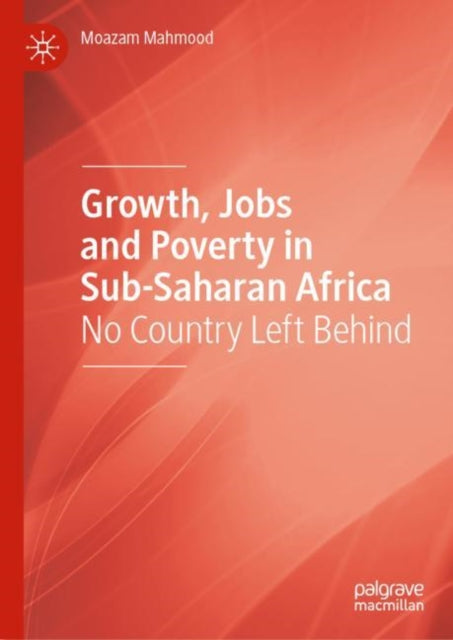Moazam Mahmood
Growth, Jobs and Poverty in Sub-Saharan Africa: No Country Left Behind
Growth, Jobs and Poverty in Sub-Saharan Africa: No Country Left Behind
YOU SAVE £15.03
- Condition: Brand new
- UK Delivery times: Usually arrives within 2 - 3 working days
- UK Shipping: Fee starts at £2.39. Subject to product weight & dimension
Bulk ordering. Want 15 or more copies? Get a personalised quote and bigger discounts. Learn more about bulk orders.
Couldn't load pickup availability
- More about Growth, Jobs and Poverty in Sub-Saharan Africa: No Country Left Behind
Sub-Saharan Africa (SSA) is characterized by its structural parameters and opportunities in low-income countries, but it also comprises higher-income countries. This book argues that SSA is constrained in its growth, employment, and poverty outcomes and that these constraints must be recognized and overcome by all countries in SSA to ensure no country is left behind. The growth in SSA is weak due to a growth path based more on extractives than manufactured goods, which is volatile and affects the entire economy.
Format: Hardback
Length: 242 pages
Publication date: 16 July 2022
Publisher: Springer Nature Switzerland AG
Sub-Saharan Africa (SSA) is a diverse region that cannot be solely defined by the structural parameters and opportunities associated with low-income countries. While it encompasses a significant number of lower-income nations, it also includes several higher-income countries. This book makes a crucial observation: SSA faces significant constraints in its growth, employment, and poverty outcomes. Rather than perceiving these limitations as a conceptual disadvantage, it is essential to acknowledge and overcome them. This challenge requires the collective efforts of all countries in SSA, rather than just a select few that may find it easier to navigate these constraints.
The book highlights a weakness in the quantum of growth experienced in SSA. It attributes this to a growth path that relies more heavily on extractives, such as minerals and oil, rather than manufactured goods. While SSA possesses abundant extractive resources, global demand for these commodities is highly volatile. The book captures this dynamic through the analysis of equilibrium in four key markets: the tradeables market, the domestic goods market, the labor market, and the money market.
The tradeables market refers to the exchange of goods and services between countries. In SSA, the export sector plays a significant role, particularly in countries rich in natural resources. However, the boom-and-bust cycles in export demand have a profound impact on the entire economy. When global demand for extractives increases, SSA's export sector experiences a boom, leading to economic growth and job creation. However, when demand declines, the export sector suffers, leading to a contraction in economic activity, job losses, and reduced income levels.
The domestic goods market, on the other hand, represents the production and consumption of goods within SSA. The growth of this market is crucial for creating employment opportunities and reducing poverty. However, the book notes that the growth of the domestic goods market in SSA has been hindered by factors such as limited infrastructure, inadequate investment in research and development, and a lack of access to capital.
The labor market is another critical aspect of SSA's economic development. The region faces significant challenges in terms of unemployment, underemployment, and informal employment. The book identifies several factors contributing to these labor market challenges, including a lack of skills and training, limited access to education, and high levels of poverty.
Finally, the money market refers to the financial system that operates within SSA. The book highlights the importance of a stable and efficient financial system in promoting economic growth and reducing poverty. However, SSA faces challenges in terms of financial inclusion, access to credit, and financial stability.
In conclusion, Sub-Saharan Africa faces significant constraints in its growth, employment, and poverty outcomes. These constraints are not solely due to the structural parameters of the region but also include factors such as volatile global demand for extractives, limited infrastructure, inadequate investment in research and development, and a lack of access to capital. To overcome these challenges, all countries in SSA must work together to promote inclusive economic growth, invest in infrastructure, enhance skills and training, and promote financial stability. Only through collective efforts can SSA achieve its full potential and ensure that no country is left behind.
Weight: 467g
Dimension: 210 x 148 (mm)
ISBN-13: 9783030915735
Edition number: 1st ed. 2022
This item can be found in:
UK and International shipping information
UK and International shipping information
UK Delivery and returns information:
- Delivery within 2 - 3 days when ordering in the UK.
- Shipping fee for UK customers from £2.39. Fully tracked shipping service available.
- Returns policy: Return within 30 days of receipt for full refund.
International deliveries:
Shulph Ink now ships to Australia, Belgium, Canada, France, Germany, Ireland, Italy, India, Luxembourg Saudi Arabia, Singapore, Spain, Netherlands, New Zealand, United Arab Emirates, United States of America.
- Delivery times: within 5 - 10 days for international orders.
- Shipping fee: charges vary for overseas orders. Only tracked services are available for most international orders. Some countries have untracked shipping options.
- Customs charges: If ordering to addresses outside the United Kingdom, you may or may not incur additional customs and duties fees during local delivery.


